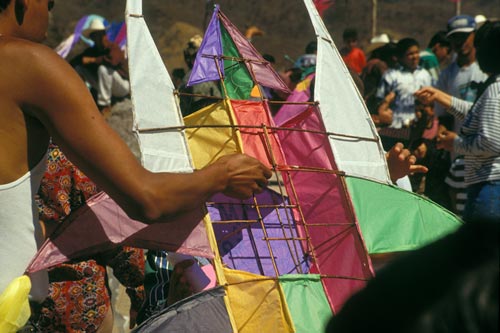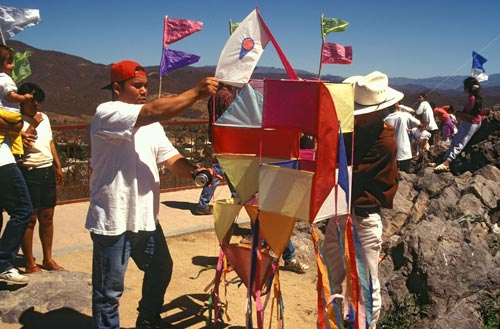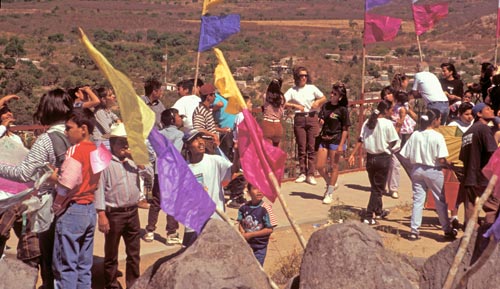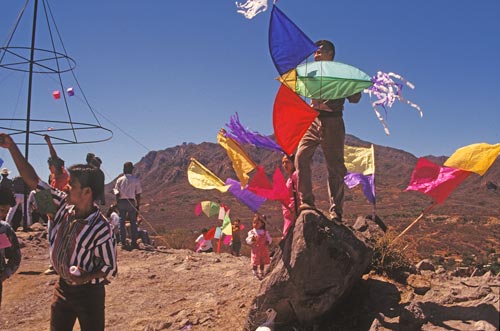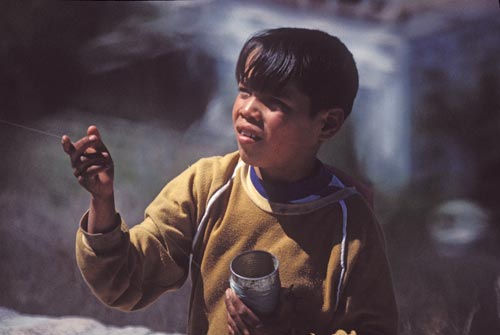Mirador Kite Festival
Last modified: April 3, 2018101… On Mirador for the kite flying contest.
The winds of Álamos more come than go and when they are blowing kite flying
takes place across the barrios. Sticks, paper, string are a child’s
opportunity to take flight and be one with the elements. The child in
all of us enjoys watching children enthralled with their kites dancing on a breeze.
On the day of the festival kites, and their builders-owners, are seen on
their way to and returning from El Mirador. Colorful pennants snapping
in the winds on El Mirador announce to the people below that today
celebrates a special event.
The kite flying contest was started by Cammie Nuzum and her then husband
Chacho Valdez. These photos are from the 1996 festival. The recent
2012 contest was sponsored by Cammie and Elizabeth Nuzum. Kites were not
always a place for children’s imaginations to soar. One of the first
written records of kite flying is from around 200 B.C., Chinese General
Han Hsin of the Han Dynasty wanted to know how far his troops would
need to tunnel to enter a rival city. He flew a kite to measure
the distance. With this information in hand his army was able to surprise
the enemy and capture the city.
Joan and Earle Winderman, that is a nice kite flying name, enjoyed a sunny
day on El Mirador. Besides myself, they were the only gringos I saw at
the festival. Whether one is flying a kite, or a spectator, everyone watches the kites.
The kites become what their builders want them to be. Days of design
and construction lead up to contest. There is much to learn building
a kite. Natural science, mathematics, aeronautics, history, culture,
art and crafts come together as a flying objects and opportunities
for self-expression.
The Museo Costumbrista de Sonora displays the kites after the contest.
For centuries kites were used by only by the military. Around the year 600,
during the Silla Dynasty of Korea, General Gim Yu-sin’s troops refused
to continue fighting because they has seen a shooting star and believed
this was a bad omen. The General sent a fire ball into the sky with a
large kite. The soldiers, seeing the star return to heaven, rallied
and defeated the rebels.
Buddhist monks brought kites to Japan around the 7th century. They were
thought to be able to protect rich harvests and deter evil spirits.
During the Edo period kite flying became very popular when Japanese
people below the samurai class were allowed to participate. The Edo
(now Tokyo) government tried unsuccessfully to discourage this pastime
as “too many people became unmindful of their work.”
Álamos is a wonderful place to fly kites especially from El Mirador
up high and open to the winds that carry molecules Caesar, Leonardo
da Vinci and Marilyn Monroe breathed. There is a timeless quality
to kite flying. It is as as much about the flyer’s thoughts as it is about flying.
Kite flying began in Asia and slowly word spread to Europe. Marco Polo,
around the end of the 13th century, brought back to Europe stories
of kite flying. Period Illustrations showed military banners
with
non-flying dragon kites. 16th and 17th century sailors brought
kites
back from Japan and Malaysia. Kites at first had little impact on
European culture and were regarded as curiosities.
Standing with their backs to the Sea of Cortez, the kite-flyers work
the western on-shore winds and the drafts that come from the eastern
Sierra Madre foothills.
As time marched on kites became universal and many used kites as scientific
research tools. In the 18th and 19th centuries men like Benjamin Franklin
and Alexander Wilson learn more about the wind and weather used their
knowledge of kite flying. Airplanes came about with the help of kite
experiments by Sir George Caley, Samuel Langley, Lawrence Hargrave,
Alexander Graham Bell, and the Wright Brothers.
Here atop El Mirador the Sea of Cortez is some fifty miles to the west
and the Copper Canyonlands are some fifty miles to the east. One
could say the kite-flyer’s feet mark the center of the universe and
their kites announce ownership of the moment.
Warmth Radiates off of Adobe Walls as Another Winter Day Begins.
Kite flying is popular in Álamos, Sonora, Mexico. Drinking beer outside
the pickup with friends is popular. Fun and work go on side by side
as we visit a wood shop.
To see more Álamos Journal pages.
To return Home.
©2013 Anders Tomlinson, all rights reserved.




